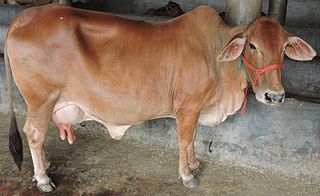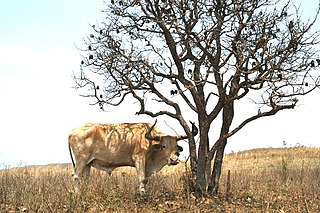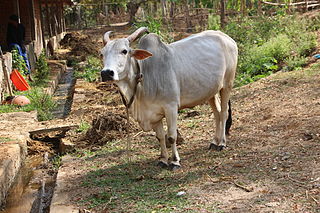
The aurochs, also known as aurochsen, urus or ure, is a species of large wild cattle that inhabited Asia, Europe and North Africa. While the wild subspecies, including the nominal subspecies Bos primigenius primigenius is extinct, extant domestic cattle are considered subspecies of the aurochs. Further discussion and use of the term "aurochs" in this article, for simplicity, refer only to the extinct wild subspecies unless otherwise specified. Bos primigenius primigenius survived in Europe until 1627, when the last recorded aurochs died in the Jaktorów Forest in Poland.

The Canchim is a breed of beef cattle developed in Central Brazil by crossing European Charolais cattle with Indubrazil cattle already kept in Brazil where Asian Zebu type cattle are best suited to the tropical conditions. When compared with Zebu bulls, Canchim bulls produce the same number of calves, but heavier and of superior quality. Compared to European breeds, the Canchim bull produces calves with the same weight but in larger numbers. The fast-growing progeny, from crossbred zebu cows with Canchim bulls, can be slaughtered at 18 months old from feedlots after weaning, up to 24 months old from feedlots after grazing and at 30 months from grazing on the range.

A zebu, sometimes known as indicine cattle or humped cattle, is a species or subspecies of domestic cattle originating in the Indian sub-continent. Zebu are characterised by a fatty hump on their shoulders, a large dewlap, and sometimes drooping ears. They are well adapted to withstanding high temperatures, and are farmed throughout the tropical countries, both as pure zebu and as hybrids with taurine cattle, the other main type of domestic cattle. Zebu are used as draught and riding animals, dairy cattle, and beef cattle, as well as for byproducts such as hides and dung for fuel and manure. Some small breeds such as the miniature zebu are also kept as pets. In 1999, researchers at Texas A&M University successfully cloned a zebu.

The Brahman is an American breed of zebuine-taurine hybrid beef cattle. It was bred in the United States from 1885 from cattle originating in India, imported at various times from the United Kingdom, from India and from Brazil. These were mainly Gir, Guzerá and Nelore stock, with some Indu-Brasil, Krishna Valley and Ongole. The Brahman has a high tolerance of heat, sunlight and humidity, and good resistance to parasites. It has been exported to many countries, particularly in the tropics; in Australia it is the most numerous breed of cattle. It has been used in the creation of numerous taurine-indicine hybrids, some of which – such as the Brangus and Brahmousin – are established as separate breeds.

The Senepol breed of beef cattle was developed on the Caribbean Island of St. Croix. It has long been thought that Senepol originated from crosses between N'Dama cattle, imported in the late 19th century, and Red Poll cattle, but it is actually an admixed breed between a European taurina and zebu. The Senepol breed combines characteristics of heat tolerance and insect resistance with the docile nature, good meat, and high milk production of the Red Poll. They are polled, short haired, and colored red, black or brown.

Santa Gertrudis cattle are a tropical beef breed of cattle developed in southern Texas on the King Ranch. They were named for the Spanish land grant where Captain Richard King originally established the King Ranch. This breed was officially recognized by the United States Department of Agriculture in 1940, becoming the first beef breed formed in the United States. The origin given by King Ranch is that it was formed by mating Brahman bulls with Beef Shorthorn cows, with the final composition being about three-eighths Brahman and five-eighths Shorthorn. In 1918, the King Ranch purchased 52 bulls of three-quarters to seven-eighths Bos indicus breeding to mate with 2500 pure-bred Shorthorn cows on the ranch. At this time, the American Brahman breed as such did not exist, nor were purebred Bos indicus cattle available in the United States.

The Gir or Gyr is one of the principal Zebu breeds originating in India. It has been used locally in the improvement of other breeds including the Red Sindhi and the Sahiwal. It was also one of the breeds used in the development of the Brahman breed in North America. In Brazil and other South American countries the Gir is used frequently because, as a Bos indicus breed, it is resistant to hot temperatures and tropical diseases. It is well known for its milk producing qualities and is often bred with Friesian cows to make the Girolando breed.
The Indu-Brasil or Indo-Brazilian is a Brazilian breed of zebuine beef cattle. It was bred in the early twentieth century in the Triângulo Mineiro in the western part of Minas Gerais state, and particularly in the area surrounding Uberaba. It was originally known as the Induberaba. It derives from imported Indian zebuine cattle, principally Gir and Kankrej. It was formerly an important beef breed, but in the twenty-first century is an endangered breed. It is characterised by particularly large ears, perhaps the largest seen in any breed of cattle.

Sahiwal cattle are a breed of zebu cow, named after an area in the Punjab, Pakistan. The cattle is mainly found in Punjab province of Pakistan, and Indian states of Punjab, Haryana, & Rajasthan.

The Australian Charbray is an Australian breed of cattle derived from a cross between the French Charolais cattle and American Brahman cattle. The charbray breed was first conceived in the United States of America in the 1930s and later introduced into Australia in 1969. In Australia, Australian charbray breeders are concentrated in the tropical Northern regions of Queensland. As of 1977, the official breeder society of Charbray cattle in Australia and New Zealand is the Charbray Society of Australia Limited, responsible for recording Charbray cattle in herd books, fostering improvement, enhancement and sales of Charbray cattle.

The Droughtmaster is an Australian breed of beef cattle. It was developed from about 1915 in North Queensland by crossing zebuine cattle with cattle of British origin, principally the Beef Shorthorn. It was the first Australian taurindicine hybrid breed; it is approximately 50% Bos indicus and 50% Bos taurus.

Sanga cattle is the collective name for indigenous cattle of sub-Saharan Africa. They are sometimes identified as a subspecies with the scientific name Bos taurus africanus. These cattle originated in East Africa, probably the western shores of Lake Victoria, and have spread down the river Nile, with depictions on Ancient Egyptian murals. Sanga are an intermediate type, probably formed by hybridizing the indigenous humpless cattle with Zebu cattle. However, archaeological evidence indicates this cattle type was domesticated independently in Africa, and bloodlines of taurine and zebu cattle were introduced only within the last few hundred years. The timeline for their history is the subject of extensive debate. A combination of genetic studies with archaeological research, including cultural history, has clarified the question of the complex origin of African cattle in recent years. Thus African cattle descend firstly from an aurochs domesticated in the Near East. After their introduction to Egypt, about eight thousand years ago, they spread all over the Sahara which was then still green, up to West Africa. The north African pastoralists interbred their domestic cattle with wild African Aurochs of various regional races, both in the paternal and maternal lines over a long time, which is reflected in the genetic distinctness of African cattle from both European / near Eastern and from Indian Zebu cattle. Hereby special adaptations to the African climate and conditions were introduced, that characterise African cattle - both those deriving solely from Aurochs and the Sanga cattle with their Zebu admixture. Morphological features of early African cattle, such as lyre-shaped horns, are depicted on murals of Ancient Egypt. Some authors date the first Sanga cattle, which originated through by crossing in of Zebu bulls in northeast and east Africa, from 1600 BC on. They are distinguished by having small cervicothoracic humps, that are typical for (wild) Aurochs, instead of the high thoracic humps which characterize the Zebu.

N'Dama is a breed of cattle from West Africa. Other names for them include Boenca or Boyenca (Guinea-Bissau), Fouta Jallon, Djallonké or Djallonké cattle, Fouta Longhorn, Fouta Malinke, Futa, Malinke, Mandingo (Liberia), and N'Dama Petite (Senegal). Originating in the Guinea highlands, they are also found in southern Senegal, Guinea-Bissau, the Gambia, Mali, Ivory Coast, Liberia, Nigeria, and Sierra Leone. They are trypanotolerant, allowing them to be kept in tsetse fly-infested areas. They also show superior resistance to ticks and the diseases they carry and to Haemonchus contortus stomach worms.

Caracu is a Brazilian dual purpose cattle breed known for its adaptability, hardiness and excellent maternal ability. . Like the Mocho Nacional, the Caracu is a tropical European breed created in Brazil; it may derive in part from the Minhota of Portugal. Its main use is as a cross to beef cattle. The Caracu accounts for less than 5% of Brazilian beef cattle; the Nelore breed is by far the predominant breed in Brazil.
Turano-Mongolian cattle are a group of taurine cattle that are found in Northern and Eastern Asia. They are morphologically and genetically distinct from the Near-Eastern group of taurine cattle, from which European cattle are descended; they may have been domesticated independently.

The Krishna Valley is an Indian breed of draught cattle. It originated in the areas drained by the Krishna, Ghataprabha and Malaprabha rivers. It is a recently-created breed, bred in the late nineteenth century as a draught animal for agricultural purposes.

Wairuna Homestead is a heritage-listed homestead at Wairuna Road, Wairuna, Tablelands Region, Queensland, Australia. It was built in 1940s by Harold and Norman Johnston. It is also known as Wairuna Station Homestead and Cemetery. It was added to the Queensland Heritage Register on 9 August 2013.
The Afar cattle are mainly found on the western margins of the Danakil Depression in Ethiopia. The Afar cattle have thick and long horns and a cervicothoracic hump; they are essentially reared for milk production.
Fogera cattle is an Ethiopian breed of cattle. One of its typical characteristics are broad hoofs, that allow it to move more easily in the marshes of the Fogera Plain. At Woreta, the agricultural research centre specialises in preserving the breed.















